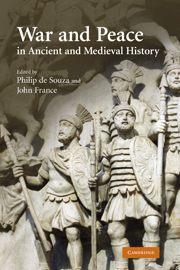Book contents
- Frontmatter
- Contents
- List of contributors
- Acknowledgements
- Note on abbreviations
- 1 Introduction
- 2 Making and breaking treaties in the Greek world
- 3 War, peace and diplomacy in Graeco-Persian relations from the sixth to the fourth century bc
- 4 Treaties, allies and the Roman conquest of Italy
- 5 Parta victoriis pax: Roman emperors as peacemakers
- 6 Treaty-making in Late Antiquity
- 7 Byzantine diplomacy: good faith, trust and co-operation in international relations in Late Antiquity
- 8 Treaties between Byzantium and the Islamic world
- 9 Siege conventions in Western Europe and the Latin East
- 10 Paying the Danegeld: Anglo-Saxon peacemaking with vikings
- 11 Peace among equals: war and treaties in twelfth-century Europe
- Bibliography
- Index
9 - Siege conventions in Western Europe and the Latin East
Published online by Cambridge University Press: 09 August 2009
- Frontmatter
- Contents
- List of contributors
- Acknowledgements
- Note on abbreviations
- 1 Introduction
- 2 Making and breaking treaties in the Greek world
- 3 War, peace and diplomacy in Graeco-Persian relations from the sixth to the fourth century bc
- 4 Treaties, allies and the Roman conquest of Italy
- 5 Parta victoriis pax: Roman emperors as peacemakers
- 6 Treaty-making in Late Antiquity
- 7 Byzantine diplomacy: good faith, trust and co-operation in international relations in Late Antiquity
- 8 Treaties between Byzantium and the Islamic world
- 9 Siege conventions in Western Europe and the Latin East
- 10 Paying the Danegeld: Anglo-Saxon peacemaking with vikings
- 11 Peace among equals: war and treaties in twelfth-century Europe
- Bibliography
- Index
Summary
War is waged differently and less vigorously between men who hold the same law and faith. For even if no other cause for hatred exists, the fact that the combatants do not share the same articles of faith is sufficient reason for constant quarrelling and enmity.
Thus William of Tyre explained the readiness of both Baldwin II (1118–32) and his enemy, Bursuqi of Mosul, to engage in battle at Azaz in 1125. But this may be taken as a text underlying the basic assumption of many writers, that crusading warfare was à l'outrance, unregulated mayhem. The twelfth century is certainly too early to speak of the ‘Laws of War’, because even within Catholic Christendom these only became codified and systematised from the thirteenth century onwards. But even at that date, certainly between warring contenders of the same religion, conventions had been established which ameliorated the brutality of war, especially regarding the treatment of prisoners, ransoms etc. The Anglo-Norman realm was in a state of continual conflict with some of its neighbours, but the behaviour of soldiers in these wars was governed by understandings which, though unwritten and uncodified, were nonetheless very influential. In Islam the redeeming of captives was a religious imperative and this formed the basis for a rather similar pattern of behaviour. Further, even before the crusades there were precedents for regulating the conduct of war between enemies of different religions.
- Type
- Chapter
- Information
- War and Peace in Ancient and Medieval History , pp. 158 - 172Publisher: Cambridge University PressPrint publication year: 2008
- 1
- Cited by



